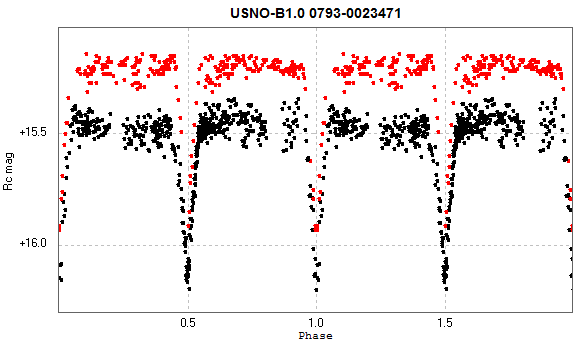| Article in PDF |
"Peremennye Zvezdy", Prilozhenie, vol. 15, N 4 (2015) |
New Algol-type Binary System in Cetus
N. Virnina
Odessa National Maritime University, Odessa, Ukraine
| ISSN 2221–0474 |
Received: 24.10.2013; accepted: 26.06.2015
(E-mail for contact: virnina@gmail.com)
| ||||||||||||||||||||||
Remarks: | ||||||||||||||||
During observations of an 88' × 59' field in Cetus, centred at α = 02h24m25s,
δ = –10°41'12", on the remotely controlled
astrophysical refractor AP-180 of the Tzec Maun observatory,
we discovered a new Algol-type binary star USNO-B1.0 0793-0023471. We used C-Munipack
software. All observations
were unfiltered; the maximum quantum efficiency of the SBIG STL-11000 CCD
camera is close to the Rc photometric band. Our observations cover 14 observing runs
in the time interval from JD 2455058
(August 15, 2009) to JD 2455121 (October 16, 2009). We used USNO B1.0 0792-0023465
(Rc = 14.973), found constant, as the reference star
for our photometrical measurements.
We searched for the period of the new binary using the Lafler–Kinman method
(Lafler & Kinman 1965) in the
Peranso
software. The star exhibits two minima of nearly equal brightness: MinI = 16.130,
MinII = 16.108.
The eclipse duration is 10.6%.
To find a more precise period, we used Catalina
Survey observations (Drake et al., 2009), which
span 2739 nights of observations.
We also measured individual minima:
Acknowledgements: The author is thankful to Dr. Zdeněk Mikulášek for helpful discussion. Special thanks are due to Ron Wodaski (director of the Tzec Maun observatory) and Donna Brown-Wodaski (director of the Tzec Maun Foundation). This publication has made use of the VizieR catalogue service, operated at CDS, Strasbourg, France and the International Variable Star Index (VSX) operated by the AAVSO. | ||||||||||||||||
| References: | ||||||||||||||||
| Drake, A.J., Djorgovski, S.G., Mahabal, A., et al., 2009, Astrophys. J., 696, 870
Lafler, J., Kinman, T.D., 1965, Astrophys. J. Suppl., 11, 216 |
Light Curve
Red data points: AP-180 observations; black data points: Catalina observations. Finding Chart 
10'× 10' chart Data Source |